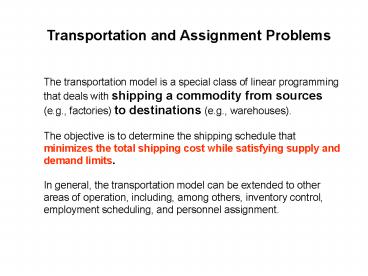Transportation and Assignment Problems - PowerPoint PPT Presentation
1 / 16
Title:
Transportation and Assignment Problems
Description:
Transportation and ... The objective is to determine the shipping schedule that ... the row or column that zeroed the corresponding supply/demand (in ... – PowerPoint PPT presentation
Number of Views:120
Avg rating:3.0/5.0
Title: Transportation and Assignment Problems
1
Transportation and Assignment Problems
The transportation model is a special class of
linear programming that deals with shipping a
commodity from sources (e.g., factories) to
destinations (e.g., warehouses). The objective
is to determine the shipping schedule that
minimizes the total shipping cost while
satisfying supply and demand limits. In
general, the transportation model can be extended
to other areas of operation, including, among
others, inventory control, employment scheduling,
and personnel assignment.
2
Transportation simplex method
- Much faster than standard simplex method
- standard simplex method
- mn1 rows
- (m1)(n1) mn m n 1 columns
- transportation simplex method
- m 2 rows
- n 2 columns
Assume m 10 n 100 and see the difference!
3
Transportation simplex method
- Initialization finding the initial BF solution
- Optimality test
- Iteration
4
General procedure for construction of an initial
basic feasible solution for TP
- From the rows and columns still under
consideration select the next basic variable
(allocation) according to some criterion - Make that allocation the largest possible (the
smallest of the remaining supply in its row vs.
remaining demand in its column) - Eliminate the row or column that zeroed the
corresponding supply/demand (in case of tie,
randomly pick between the row vs. column this is
a case of a degenerate basic solution, i.e, a
basic variable with value 0). - If only one row or column remains under
consideration, then the procedure is complete by
selecting every remaining variable associated
with that row or column to be basic with the only
feasible allocation. Otherwise return to step 1.
5
Criteria for selecting next basic variable
- There are several methods. Here are three
- Northwest Corner Method
- Minimum Cost Method
- Vogels Method
6
1. Northwest Corner Method
- To find the bfs by the NWC method
- Begin in the upper left (northwest) corner of the
transportation tableau and set x11 as large as
possible (here the limitations for setting x11 to
a larger number, will be the demand of demand
point 1 and the supply of supply point 1. Your
x11 value can not be greater than minimum of this
2 values).
7
According to the explanations in the previous
slide we can set x113 (meaning demand of demand
point 1 is satisfied by supply point 1).
8
After we check the east and south cells, we saw
that we can go east (meaning supply point 1 still
has capacity to fulfill some demand).
9
After applying the same procedure, we saw that we
can go south this time (meaning demand point 2
needs more supply by supply point 2).
10
Finally, we will have the following bfs, which
is x113, x122, x223, x232, x241, x342
11
2. Vogels Method
- Begin with computing each row and column a
penalty. The penalty will be equal to the
difference between the two smallest shipping
costs in the row or column. - Identify the row or column with the largest
penalty. Find the first basic variable which has
the smallest shipping cost in that row or column.
Assign the highest possible value to that
variable, and cross-out the row or column as in
the previous methods. - Compute new penalties and use the same procedure.
12
An example for Vogels MethodStep 1 Compute the
penalties.
13
Step 2 Identify the largest penalty and assign
the highest possible value to the variable.
14
Step 3 Identify the largest penalty and assign
the highest possible value to the variable.
15
Step 4 Identify the largest penalty and assign
the highest possible value to the variable.
16
Step 5 Finally the bfs is found as X110, X125,
X135, and X2115































